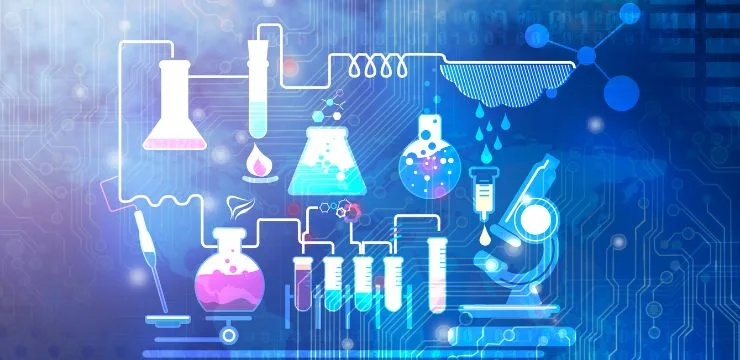NEET UG Chemistry Syllabus 2025: The National Eligibility cum Entrance Test (NEET-UG) is a highly competitive examination conducted annually by the National Testing Agency (NTA) for students seeking admission to MBBS, BDS, and other allied health courses in various government and private medical colleges in India. Aspiring candidates who wish to pursue a career in the medical field need to have a thorough understanding of the NEET chemistry syllabus.
The NEET chemistry syllabus for the year 2025 comprises topics from both Class 11 and 12. The syllabus has been designed to test the candidates’ knowledge and comprehension of basic chemistry concepts, principles, and applications. The NEET chemistry syllabus is divided into three sections, namely physical chemistry, organic chemistry, and inorganic chemistry.
[Page Index]
NEET UG Syllabus 2025: Quick Fact
Before going into a deep discussion of the NEET Physics syllabus, let’s check some quick facts about the NEET 2025 Syllabus below mention table.
| Particulars | Details |
|---|---|
| Issuing Authority of NEET UG 2025 Syllabus PDF | NTA (National Testing Agency) |
| Official Website for releasing NEET UG Syllabus PDF | neet.nta.nic.in |
| Subjects in NEET UG Syllabus | Chemistry, Physics, Biology (Zoology and Botany) |
| Total Number of Questions in the NEET UG Exam | 200 |
| No. of Questions from NEET UG Chemistry Section | 50 |
| No. of Questions from NEET UG Physics Section | 50 |
| No. of Questions from NEET UG Biology Section | 100 (50 each in Zoology & Botany) |
NEET UG Chemistry Syllabus 2025 Chapter-wise
The NEET UG Chemistry 2025 syllabus is divided into chapters. For their preparation, candidates must prepare specific chapters from class 11th and 12th Chemistry. The following are the topics organised by chapter:
Class 11th chapter-wise NEET-UG Chemistry syllabus
| Unit | Topics |
| Unit 1 – Some Basic Concepts of Chemistry | Matter and its nature, Dalton’s atomic theory: Concept of atom, molecule, element, and compound, Laws of chemical combination, Atomic and molecular masses, Mole concept, molar mass, Percentage composition, empirical and molecular formulae, Chemical equations and stoichiometry |
| Unit 2 – Structure of Atom | Nature of electromagnetic radiation, photoelectric effect, Spectrum of the hydrogen atom, Bohr model: Postulates, energy relations, orbit radii, and limitations, Dual nature of matter and radiation, de Broglie relationship, Heisenberg uncertainty principle, Quantum mechanical model of the atom, Atomic orbitals: Shapes of s, p, d orbitals, Quantum numbers, Aufbau principle, Pauli’s exclusion principle, Hund’s rule, Electronic configurations and stability of orbitals |
| Unit 3: Classification of Elements and Periodicity | Modern periodic law and periodic table s, p, d, and f block elements, Periodic trends: Atomic radii, ionization energy, electron gain enthalpy, and electronegativity |
| Unit 4: Chemical Bonding and Molecular Structure | Kossel-Lewis approach, Ionic and covalent bonding, Factors affecting ionic bonds, lattice enthalpy, Fajan’s rule, dipole moment, VSEPR theory and shapes of molecules, Valence bond theory, Molecular orbital theory: Bonding and antibonding orbitals, bond order, bond length, Hydrogen bonding |
| Unit 5: States of Matter: Gases and Liquids | Gas laws: Boyle’s, Charle’s, Avogadro’s law, Ideal gas equation, kinetic theory, Liquids: Vapour pressure, viscosity, surface tension |
| Unit 6 – Thermodynamics | System and surroundings, Internal energy, enthalpy, heat capacity, First law of thermodynamics, enthalpy changes, Hess’s law, Spontaneous processes, entropy, and Gibbs free energy |
| Unit 7 – Equilibrium | Equilibrium in physical and chemical processes, Law of mass action, equilibrium constant, Le Chatelier’s principle, Ionic equilibrium: pH, buffer solutions, solubility product |
| Unit 8 –Redox Reactions | Oxidation and reduction concepts, Oxidation number, Balancing redox reactions |
| Unit 9 – Hydrogen | Occurrence, isotopes, and properties of hydrogen,Preparation and properties of hydrides, Water, hydrogen peroxide: Properties and structure |
| Unit 10 –s-Block Elements(Alkali and alkaline earth metals) | Group 1 (alkali metals) and Group 2 (alkaline earth metals), Properties, uses, and compounds like NaOH, CaCO₃ |
| Unit 11: Some p-Block Elements (Group 13 and 14) | Boron and its compounds, Carbon family: Allotropes, compounds like CO₂, and silicon compounds |
| Unit 12: Organic Chemistry: Some Basic Principles | Classification and nomenclature, Covalent bond fission: Free radicals, carbocations, Inductive effect, resonance, Reaction mechanisms: Substitution, addition, elimination |
| Unit 13 – Hydrocarbons | Alkanes, alkenes, and alkynes: Properties and reactions, Aromatic hydrocarbons: Benzene, electrophilic substitution reactions |
| Unit 14 – Environmental Chemistry | Environmental pollution, greenhouse gases, ozone depletion |
Class 12th chapter-wise NEET-UG Chemistry syllabus
| Unit | Topics |
| Unit 1 – Solid State | Classification of solids, Crystal lattices and unit cells, Imperfections in solids, Electrical and magnetic properties |
| Unit 2 – Solutions | Concentration terms: Molarity, molality, mole fraction, Raoult’s law, ideal and non-ideal solutions, Colligative properties: Freezing point depression, boiling point elevation, osmotic pressure, Abnormal molecular masses, van’t Hoff factor |
| Unit 3 – Electrochemistry | Electrochemical cells, Galvanic cells, Nernst equation, Conductance and Kohlrausch’s law, Electrolysis and Faraday’s laws, Fuel cells, batteries |
| Unit 4 – Chemical Kinetics | Rate of reaction, Rate law and order of reaction, Arrhenius equation, Catalysis |
| Unit 5 – Surface Chemistry | Adsorption, isotherms, Catalysis, Colloids and emulsions |
| Unit 6: The p-Block Elements | Group 15–18 elements, Properties and compounds like NH₃, HNO₃, H₂SO₄, and halogens |
| Unit 7: The d- and f-Block Elements | Transition elements: Trends, properties, compounds, Inner transition elements: Lanthanoids and actinoids |
| Unit 8 –Coordination Compounds | Werner’s theory, Nomenclature – Bonding (VBT and CFT), Applications |
| Unit 9 – Haloalkanes and Haloarenes | Properties and reactions, Environmental effects of halogenated compounds |
| Unit 10 – Alcohols, Phenols and Ethers | Properties and reactions, Mechanisms like dehydration and Reimer, Tiemann reaction |
| Unit 11 – Aldehydes, Ketones and Carboxylic Acids | Properties and reactions: Aldol condensation, Cannizzaro reaction |
| Unit 12 – Organic Compounds containing Nitrogen | Amines: Properties and classification, Diazonium salts and their reactions |
| Unit 13 –Biomolecules | Carbohydrates, proteins, nucleic acids, Enzymes, vitamins |
| Unit 14 – Polymers | Types and uses of polymers: Natural and synthetic |
| Unit 15 – Chemistry in Everyday Life | Drugs and their classification, Cleansing agents |

NEET UG Chemistry 2025 Syllabus Chapter-wise Weightage
The NEET UG chemistry syllabus with weightage is an essential tool for candidates to prepare for the examination. The weightage for each topic varies, and candidates need to focus more on the topics with a higher weightage.
| Class 11 Chemistry Section | The weightage (approximate) |
| Inorganic Chemistry | 13% |
| Organic Chemistry | 11% |
| Physical Chemistry | 22% |
| Class 12 Chemistry Section | The weightage (approximate) |
| Inorganic Chemistry | 16% |
| Organic Chemistry | 22% |
| Physical Chemistry | 16% |
NEET UG Chemistry Important Topics
This table mentions the all important topics of the NEET UG Chemistry syllabus for classes 11th & 12th. Let’s look:
| Laws of Chemical Combination | Aufbau Principle Pauli S Exclusion Principle Hund S Rule |
| Atomic Number and Mass Number | Difference Between Sigma Bond and Pi Bond |
| Hunds Rule | 118 Element Their Symbols and Atomic Numbers |
| Difference Between Molecules and Compounds | Aufbau Principle |
| Atomic Number and Mass Number Isotopes and Isobars | Lewis Dot Structure |
| Periodic Classification of Elements | Valence Bond Theory |
| Difference Between Atom and Molecule | Gay Lussac Law |
| Electron Configuration | Homogeneous Equilibrium |
| Modern Periodic Table and Its Significance | Hybridization |
| Mole Concept | Heat Capacity Cp Cv Relation |
| Heterogeneous Equilibrium | Heterogeneous Equilibrium |
| Charle S Law | Charle S Law |
| Enthalpy Change | Enthalpy Change |
| Oxidation and Reduction | Reducing Agents |
Best Book for NEET UG 2025 Chemistry
The NEET chemistry section consists of 50 questions with a maximum of 180 marks and is divided into three sections: organic, inorganic, and physical. According to the previous year’s trends, the Physical and Organic sections are more weighted, with the Physical section containing numerical-based questions. Compared to the other two sections, the inorganic section is the easiest; it consists of memory-based questions.
Read also:



